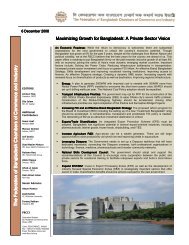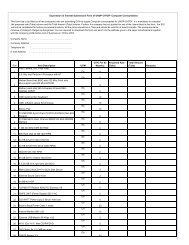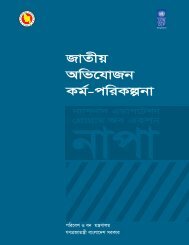Framework for a Strategy of UP Revenue/Resource Mobilisation ...
Framework for a Strategy of UP Revenue/Resource Mobilisation ...
Framework for a Strategy of UP Revenue/Resource Mobilisation ...
You also want an ePaper? Increase the reach of your titles
YUMPU automatically turns print PDFs into web optimized ePapers that Google loves.
at the ceiling rate <strong>of</strong> Taka 500, including a number <strong>of</strong> multi-storey blocks <strong>of</strong> rooms <strong>for</strong> garment<br />
workers. 10 Overall, the average assessment was probably around Taka 35 to Taka 50.<br />
c. Present <strong>Revenue</strong> Collection and its Per<strong>for</strong>mance<br />
Bills are not issued <strong>for</strong> holding tax. This is not surprising, given the small amounts involved and the<br />
cost <strong>of</strong> issuing bills. Instead, either taxpayer comes to the <strong>UP</strong> <strong>of</strong>fice to pay or tax collectors<br />
contracted by the <strong>UP</strong> go house-to-house to collect the tax. Payments can be in more than one<br />
instalment (normally two). Collectors (up to one per ward, but <strong>of</strong>ten only one <strong>for</strong> the <strong>UP</strong>) are paid<br />
15% commission. This commission is supposed to be paid from the bank once the money collected<br />
has been deposited into the bank, although it seems likely that, in many cases, collectors deduct<br />
their commission be<strong>for</strong>e depositing the money. Collectors are issued with a ward register <strong>of</strong><br />
properties and their assessed values, and with serially numbered receipt books. Every few days (or<br />
once a receipt book is used up), the cash is deposited at the <strong>UP</strong> <strong>of</strong>fice, and the receipt book and<br />
register are checked by the <strong>UP</strong> Secretary against the cash be<strong>for</strong>e the money is deposited in the bank.<br />
A chronological register is also kept <strong>of</strong> all payments received, together with the number <strong>of</strong> the<br />
receipt issued.<br />
In the <strong>UP</strong>s where a relatively high proportion <strong>of</strong> tax assessments are recorded as being collected,<br />
this leaves little scope <strong>for</strong> fraud or collusion. However, there are, no doubt, places where the system<br />
is not operating properly. There could be fraud in terms <strong>of</strong> collectors pocketing the tax payment and<br />
not issuing a receipt, or issuing fake receipts; or there could be collusion between taxpayer and<br />
collector to pay a smaller amount, again without a receipt. But unless there is a record <strong>of</strong> payments<br />
against assessments, it is not obvious which households have not paid. If no record <strong>of</strong> defaulters is<br />
ever produced or publicised, and if no action is taken against defaulters except follow-up by the<br />
same collector who had perpetrated the fraud, then the fraud may never be revealed. Such fraud can<br />
be countered by producing and publishing a list <strong>of</strong> defaulters, so that taxpayers who have paid<br />
without getting a genuine receipt will complain. It could also be countered by rotating tax collectors<br />
between wards so that follow-up <strong>of</strong> apparent defaulters reveals any fraud. However, rotating<br />
collectors may be difficult if the system is <strong>for</strong> them to collect from the ward where they live.<br />
The system used in most <strong>UP</strong>s does not make it easy to identify and hence follow-up non-payers.<br />
Collections are recorded in a chronological register. Although this records the plot number, it would<br />
10 Where such blocks consist <strong>of</strong> separate apartments, presumably each apartment can be taxed separately, but where<br />
the block consists <strong>of</strong> multiple rooms, <strong>for</strong> example <strong>for</strong> garment workers, then only one tax can be levied on the whole<br />
block. In one <strong>UP</strong>, such a block was reported to be earning a monthly rental <strong>of</strong> well over Taka 10,000, yet the<br />
maximum annual tax that could be levied was Taka 500.<br />
10










